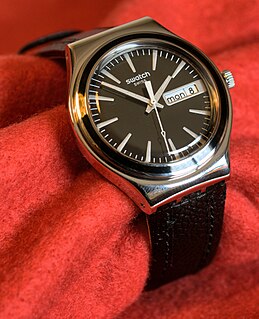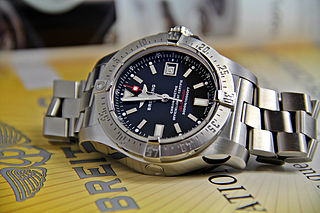
A watch is a timepiece intended to be carried or worn by a person. It is designed to keep working despite the motions caused by the person's activities. A wristwatch is designed to be worn around the wrist, attached by a watch strap or other type of bracelet. A pocket watch is designed for a person to carry in a pocket. The study of timekeeping is known as horology.

Seiko Holdings Corporation, commonly known as Seiko, is a Japanese holding company that has subsidiaries which manufactures and sells watches, clocks, electronic devices, semiconductors, jewelries, and optical products.
TAG Heuer S.A. is a Swiss luxury manufacturing company that designs, manufactures and markets watches and fashion accessories, as well as eyewear and mobile phones manufactured under license by other companies and carrying the Tag Heuer brand name.

ETA SA Manufacture Horlogère Suisse designs and manufactures quartz watches and both hand-wound and automatic-winding mechanical ébauches and movements. Commonly referred to as ETA, the company is headquartered in Grenchen, Switzerland and is a wholly owned subsidiary of The Swatch Group Ltd.

Omega Speedmaster is a line of chronograph wristwatches produced by Omega SA. While chronographs have been around since the late 1800s, Omega first introduced this line of chronographs in 1957. Since then, many different chronograph movements have been marketed under the Speedmaster name. The manual winding Speedmaster Professional or "Moonwatch" is the best-known and longest-produced; it was worn during the first American spacewalk as part of NASA's Gemini 4 mission and was the first watch worn by an astronaut walking on the Moon during the Apollo 11 mission. The Speedmaster Professional remains one of several watches qualified by NASA for spaceflight and is still the only one so qualified for EVA. The Speedmaster line also includes other models, including analog-digital and automatic mechanical watches.

The Rolex Cosmograph Daytona is a mechanical chronograph wristwatch. It has been manufactured by Rolex since 1963 in three distinct generations ; the second series was introduced in 1988, and the third in 2000. While cosmetically similar, the second series introduced a self-winding movement, and the third series brought manufacture of the movement in-house to Rolex.

The Rolex Oyster Perpetual Submariner is a line of sports watches designed for diving manufactured by Rolex, known for their resistance to water and corrosion. The first Submariner was introduced to the public in 1954 at the Basel Watch Fair. The Rolex Submariner is considered "a classic among wristwatches", manufactured by one of the most widely recognized luxury brands in the world. Due to its popularity there are many homage watches by well-established watchmakers as well as illegal counterfeits. The Rolex Submariner is part of Rolex's Oyster Perpetual line.

Double chronograph is a watch that includes two separate stopwatch mechanisms in order to estimate two separate events of different durations. It is often confused with the flyback chronograph.

A diving watch, also commonly referred to as a diver's or dive watch, is a watch designed for underwater diving that features, as a minimum, a water resistance greater than 1.0 MPa (10 atm), the equivalent of 100 m (330 ft). The typical diver's watch will have a water resistance of around 200 to 300 m, though modern technology allows the creation of diving watches that can go much deeper. A true contemporary diver's watch is in accordance with the ISO 6425 standard, which defines test standards and features for watches suitable for diving with underwater breathing apparatus in depths of 100 m (330 ft) or more. Watches conforming to ISO 6425 are marked with the word DIVER'S to distinguish ISO 6425 conformant diving watches from watches that might not be suitable for actual scuba diving.

The TAG Heuer Monaco is a series of automatic chronograph wristwatch originally introduced by Heuer in 1969 in honour of the Monaco Grand Prix. The Monaco was revolutionary for being the first automatic as well as the first square cased chronograph. The Hollywood film star Steve McQueen used the watch to accessorize his character in the 1971 film Le Mans. In the decades after his death the use of film stills has made the watch synonymous with McQueen. Although it was discontinued in the mid-1970s, the Monaco was reissued with a new design in 1998 and was reintroduced again with an entirely new mechanisms in 2003 in response to McQueen's increasing popularity.
The Flying Officer chronograph wristwatch (1939–present), designed and manufactured in La Chaux-de-Fonds, Switzerland by Gallet & Co., was commissioned by Senator Harry S. Truman from Missouri in 1939 for pilots and navigators of the United States Army Air Forces.

The Omega Marine Chronometer was the first quartz wristwatch ever to be awarded certified status as a marine chronometer. The watch was made by Omega SA and developed by John Othenin-Girard and is one of the most accurate non thermo-compensated production watches ever made, keeping time to within 1 second per month

The Omega Chrono-Quartz was the world’s first digital/ analogue chronograph. It was invented by Omega SA. The watch launched at the 1976 Montreal Olympic Games and was Omega's flagship chronograph at that time. The watch is noteworthy as it was the first chronograph wristwatch in the world to combine analogue display for the time functions and a digital display for the chronograph function, each working independently of one another but running on the same quartz resonator. (32 kHz)

The Omega 28.9 Chronograph was Omega's first small wrist chronograph. Introduced in 1932 as the Lemania caliber CH13, production continued until 1943. Lemania was acquired by the same mother company as Omega, SSIH, in 1932. Watches based on this movement paved the way for Omega to become one of the most successful manufacturers of Swiss made wrist chronographs.

The Omega Seamaster Planet Ocean is an automatic professional Swiss made luxury diving watch designed and manufactured by Omega SA since 2005. It belongs to the Seamaster line and has been characterized, since the beginning of its production, by a 600m/2000ft water resistance, a helium release valve, and the chronometer certification. Throughout its history, many authoritative international sources have often mentioned it as one of the greatest dive watches of all time.

Memovox refers to a model series of mechanical wristwatches with alarm function of the Swiss watch manufacturer Jaeger-LeCoultre.




















